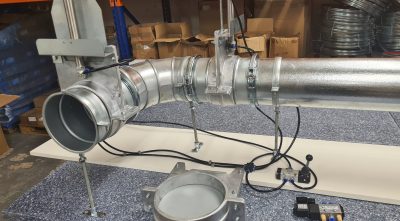There are a range of dampers available for different uses (from blast gates, to butterfly dampers, to fire dampers & so on). It can get a little confusing. In this article, we look at pneumatic blast gate dampers & how they differ from standard blast gates & have made a video to show the different types.
What is a pneumatic blast gate damper?
Pneumatic blast gate dampers are dampers that are controlled by compressed air. Typically, they are fitted with a solenoid which is mounted to the device and which will open or close the device in answer to an electric signal from machinery.
What is the difference between a blast gate damper & a pneumatic blast gate damper?
Blast gate dampers can be opened & closed to control airflow through your ducting. A standard blast gate damper can be opened & closed manually & locked off with a thumbscrew.
Pneumatic blast gate dampers are similar but with the addition of a pneumatic mechanism that enables the damper to be opened & closed automatically.
Benefits of Pneumatic Blast Gate Dampers:
- If you have a number of dampers, the system becomes easier to control
- If you want your dampers to respond to the activation of machinery, the solenoid controls make this possible
- If your ducting is situated out of reach, it doesn’t have to be opened & closed by hand
- It is a labour-saving & time-saving device which helps to prevent human error
There aren’t really disadvantages of pneumatic blast gate dampers but they do require compressed air & will cost more than a standard blast gate because of the addition of the pneumatic & automatic elements.
We have prepared a video showing the different types of damper & their differences. This video forms part of a series on blast gate dampers so that installers can understand what would be best for their installation.
Further Information
If you have any questions about dampers, blast gates, & pneumatic blast gates, give Ducting Express a call at 01455 616 444. A member of our experienced team can provide you with further information suited to your workshop’s requirements.
